Marking time in May 2016
Christopher Hume Moore, photographer
Back in the year two thousand and two, when I started to take a more serious interest in the few old photographs I owned, I uploaded a web gallery of cartes-de-visite by Queensland photographers. By early 2003 there were 18 photographs on display there, representing the work of ten studios.
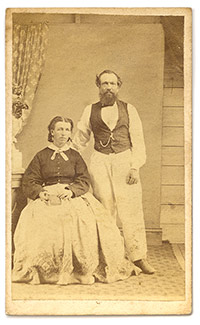
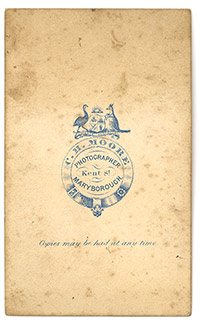
I have just uploaded this carte-de-visite by C H Moore. It is the 120th item added to the gallery, so I’ll mark the occasion by giving it special attention here. Like all of these little pictures it has more than one story behind it.
When I began this project my essential reference was Alan Davies’ and Peter Stanbury’s book The mechanical eye in Australia: photography 1841-1900 (Melbourne: Oxford University Press, 1985). The book includes a detailed list, with dates and places, of professional photographers who worked in Australia before 1900, and amateurs before 1880. The list was compiled by researchers who extracted much of the information from historical newspapers on microfilm.
Since the National Library of Australia’s wonderful Trove digitised newspapers project came online I have been able to do my own newspaper research, in a less-tedious way, and without leaving my desk.
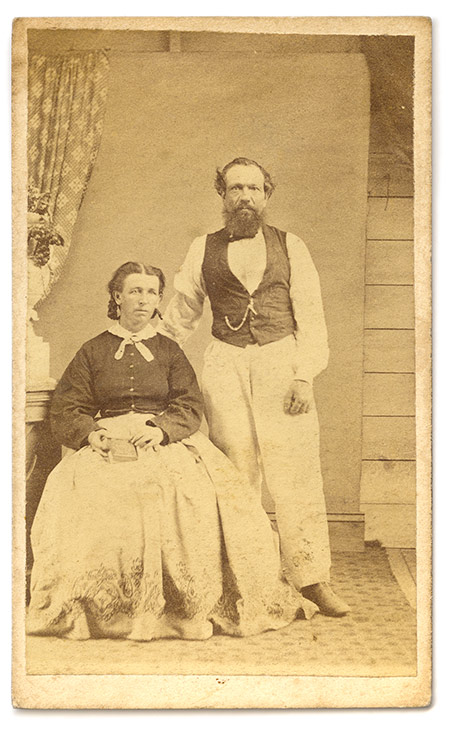
In C H Moore’s photograph the two subjects are well dressed and carefully posed in a conventional arrangement. The image is sharply focussed, there is no sign of movement blur, head-clamps (if they were used) have been skillfully hidden, and the drapery on the left is an attempt to signify a certain style. But an error in aiming the camera has cropped off the stylish curtain, and revealed that the picture was probably shot on a verandah dressed up with a backdrop and a piece of linoleum. I immediately guess that this is the work of an itinerant photographer who carted his equipment from place to place, rather than doing steady business in a well-set-up studio. C H Moore’s entry in The mechanical eye has travelling photographer at the bottom, which fits.
A quick search of Queensland newspapers, via Trove, told me more about Christopher Hume Moore’s practice as a photographer. He comes across as an energetic fellow who was willing to adapt and to follow opportunities—important qualities for a photographer in Queen Victoria’s time.
Moore’s name first shows up in the Maryborough Chronicle, Wide Bay and Burnett Advertiser of 18 May 1867, where he advertised that he had bought the photographic business of Ashbury Bright—a business that had operated in Maryborough for the previous four years.
On 11 September 1867 the Chronicle included this advertorial piece:
Our Photographic Artist, Mr Moore, has lately made several additions to the apparatus of his studio; amongst other things a very large camera for taking large portraits and views. Yesterday we had the pleasure of seeing some specimens of the production of this new instrument, amongst others of a view of the Commercial Bank, which is admirably taken, as they all are—the picture being sharp and clearly defined, and artisticallv placed with a view to effect. We recommend persons who wish to perpetuate the flitting image of themselves, or of their abodes as they appear to-day, to avail themselves of the aid which Mr Moore proffers them.
In January 1868 Moore ran big advertisements in the Chronicle urging readers to come to his studio to have their portraits taken without delay, since he was planning to be away for two months taking photographs around the gold diggings. By early February he had engaged another photographer and was offering photographic services in Nashville (the place we now call Gympie) as well as in Maryborough.
Perhaps he over-extended himself, and ran into cash-flow problems—still a pitfall for expanding small businesses. The Gympie Times and Mary River Mining Gazette of 20 February 1869 printed this:
A deed of composition has been registered, whereby C H Moore, Photographic artist of Maryborough, covenants to pay his creditors two instalments in the £ the first forthwith, and the second on the 23rd July.
Things were going better for him in September 1869 when the governor of Queensland, Colonel Sir Samuel Blackall, while on a visit to Maryborough, stopped at Moore’s studio to be photographed. A few days later the photographer advertised veritable portraits of His Excellency the Governor at a shilling each for cartes-de-visite, two shillings and sixpence for whole plate prints, and seven shillings and sixpence for prints Mounted in handsomely polished Cedar Frames.
Perhaps the story of Governor Blackall’s visit to Moore’s studio in Maryborough, jotted in a researcher’s notes, was misinterpreted and turned into the statement in The mechanical eye that Moore was based at Blackall (the town) in 1869. I could not find any mention of Moore in the Blackall district in the contemporary newspapers that are searchable in Trove.
It appears that Christopher Moore maintained a connection with Ashbury Bright, from whom he bought the photographic business in Maryborough. The Chronicle carried this advertorial piece on 17 September 1868:
Our photographist, Mr Moore, has purchased of Mr A Bright his splendid set of negatives of views taken on the several stations of the Wide Bay and Burnett. Having also taken some very fine views himself, Mr Moore intends publishing a set of photographs of scenes in town and country, which may be bound in albums or kept in portfolios, and which will form one of the most appropriate and handsome presents that could be made by anyone living in the district to a distant friend. Mr Moore ought to be well patronised, and we hope will be, for his enterprise and skill.
The Chronicle of 28 December 1871 reported news from the town of Gayndah, including this:
Messrs Moore and Harris, photographers, from Maryborough, have arrived in town, and have taken up their quarters at the Gayndah Hotel. Mr Moore is well known in Gayndah, and well liked, and it is hoped that he and his partner will do as well as Mr Moore did on his previous visit to us. They visit Mount Perry before returning to Maryborough.
In April 1872 C H Moore had been in Mount Perry, the site of a newly-established copper mine and smelter, as the Chronicle reported:
We have seen some very pretty views of Mount Perry and its neighbourhood, taken by Mr C H Moore, photographer, late of this town. They convey a most pleasing idea of the romantic scenery of that locality, which from all we can learn, abounds in attractions to the lover of the picturesque. The representations of the township, smelting works, &c., in their present primitive condition, are, perhaps, not equally gratifying to the eye, but they are interesting as illustrations of the rude beginnings from which an interest of vast magnitude is even now springing, and will, in years to come possess an historical value which will always secure for them a brisk demand.
In the same article it was mentioned that Thomas Mathewson, Photographic Artist, was coming to Maryborough to take portraits. Photography was a competitive business.
Small advertisements in the Chronicle in December 1874 announced that C H Moore had taken over the studio in Kent Street, Maryborough, lately occupied by Mr E H Forster. In the same paper, Forster ran larger advertisements announcing his new premises in Adelaide Street.
My final quote is from the Chronicle, 19 October 1875:
It is with deep regret that we have to report the sudden death of Mr C H Moore, the photographer. Friday morning he was in the enjoyment of his usual health, and embanked on board the steamer Effie with a number of excursionists to attend the tea-meeting at the Mary River Saw-mills. While going up the river he complained of being unwell, and mentioned that he believed that one of his bilious attacks’ was coming on. Shortly after complaining he became worse, and had to lie down. He had lost all consciousness before he reached the landing place. It is not pleasant to record that the invalid was carried to a house to which he was refused admittance, the charitable inmate fearing lest the sick man should bring infection with him. Finally the residence of a good Samaritan was found, and here poor Moore for a while found shelter. However, he never rallied. He was conveyed back to town by the steamer, and died at about seven o’clock the same evening. Death doubtless resulted from heart disease, from which the deceased had long been a sufferer He was only 30 years of age, and leaves a wife and four young children entirely unprovided for.
In November 1875 the Chronicle included an invitation to an amateur concert in aid of C H Moore’s widow and family, and a series of advertisements for his photographic equipment and stock.
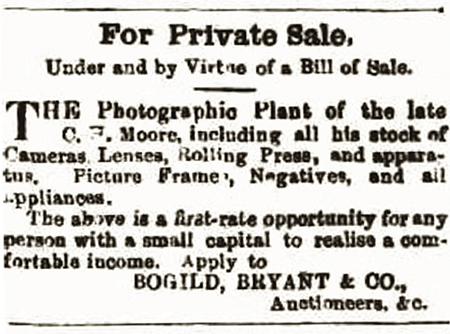
Steamship ‘Normanby’
I have added a photograph of the RMS Normanby to my little stash of steamship carte-de-visite photos with accommodation plans on the back. The photo of the Normanby joins the ones of Hibernian and Denmark which I have already mentioned here.
The Normanby has a special interest for me because of its connection with Queensland, and the colonial government’s efforts to develop the northern shipping route that linked the colony to Asia and Europe through the Torres Strait. Before this route was opened, most ships from overseas arrived in Queensland only after calling at the southern colonies. The government built port facilities, dredged rivers, erected lighthouses, and offered profitable contracts to shipping companies to carry mail along this route.
The first of these contracts was awarded to the Eastern & Australian Mail Steam Co, a company formed in 1873 to operate a four-weekly mail and passenger service from Sydney to Brisbane, Batavia (now Jakarta), Singapore and Hong Kong. One of the first ships in the company’s fleet was the RMS Normanby, built in Glasgow and launched in 1874. The prefix RMS stood for Royal Mail Ship, a mark of quality and reliability.
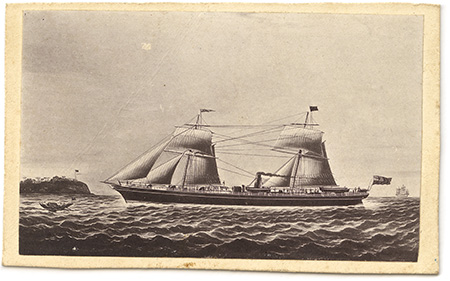
When the newly-built Normanby arrived Queenslanders were keen to know about the ship, and its promise of faster communication with the old country. Local newspapers fanned that interest. Here is the Brisbane Courier’s description of the first and second-class passengers’ accommodation—see the plan on the back of the carte-de-visite, below:
Below, the accommodation is very comfortable. The saloon is aft, and of considerable length, with state rooms on both sides. The panelling is of varnished teak, picked out with white and gold, and looks very handsome. Over the tables punkahs are hung, so as to fan the passengers while at meals, but, as a matter of fact, during the voyage from Singapore hardly a meal was eaten below, the skylight lids on deck being made to project so as to admit of passengers sitting at them conveniently. On these the meals were served, and all the advantage of additional coolness and fresher breezes secured. There is a spacious ladies’ cabin with a bath-room and other conveniences attached, and a passage opening forward from the main saloon leads to a series of offices, including several bath-rooms, &c, an ice-room capable of storing about two tons, a surgery, lamp-room, steward’s pantry, mail-room &c. This passage eventually opens into the quarters for Chinese passengers, which occupy a complete section of the ship on the same level as the saloon, from side to side. A very neat arrangement permits of the berths here being built in a few minutes, or stowed away according to the number of passengers. The place is ventilated by a number of round port-holes, and is nice and airy but in these round openings are fitted in large square ports of great size, which can be opened in fine weather, and will make discomfort from confined air an impossibility. Further on, but only accessible from the deck, is the second cabin accommodation, also very airy and good, and opening from it is a cabin for females, stretching right across the width of the ship, and thus securing a thorough draught from the opposite port-holes. This is a capital cabin of its class, and will contain nine persons without invading a couple of sofa seats, which can, if necessary, be made into additional berths. There are separate cooking places for Europeans and Chinese. The former are served from a regular ship’s galley, whose door is a neat tesselated pavement, while the latter have a fireplace sheltered outwardly, but open to the deck near the bows. A very large staff of stewards, cooks, &c., are kept. These are for the most part Chinese, and appear a docile and very cleanly set of servants. The head steward and second steward are Europeans, The ship is steered from the bridge, which is well forward, so that the steersman can command a perfect view ahead. On the bridge, also, is a neat chart room, nicely fitted with cushioned seats, for the officers, and a very cool and breezy spot at all times. Double awnings protect the after-deck from the heat of the sun, being arranged like a tent and fly.
—from ‘The Torres Strait mail steamer Normanby’, Brisbane Courier, 14 December 1874
in 1877 the Normanby, steaming north, hit an uncharted rock near Pine Islet. The hull was damaged and the ship started to take in water. Immediate action by the captain and crew saved the ship, its passengers and crew. Here is the story as told by a Sydney newspaper:
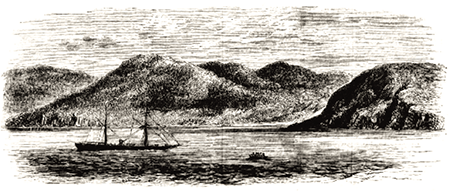
The picture on the first page of our supplement shows the position of the steamship Normanby on Percy Island. This group is about sixty miles off the coast of Queensland, in about the latitude of Cape Palmerston. The steamer, on a northward trip, left Moreton Bay on August 11, at 10 p.m., immediately after receiving her mails. Made a good run to Keppel Bay, and, after a detention of two hours, resumed her passage thence at 10 a.m. on Monday, 13th. Had a light fair breeze all day, keeping up about ten knots. At half-past 9 p.m. she suddenly struck a rock. The pilot in charge being at his post on the bridge, Captain Reddell at once took command on deck, singing out, ‘Boat stations,’ and at once every officer and man was at his allotted station, the boat-falls were cleared and half lowered, and the momentary confusion ceased. Meanwhile, it having been found that the forehold had made four feet of water in some three minutes, the ship was steered at full speed directly for the nearest available beach, which was reached in about twenty minutes, the distance being about two miles. By the time she grounded on the beach the ship was very much down by the head from the weight of water accumulating in the fore compartments, and it would seem probable that on the rapid execution of this manoeuvre depended the safety of the ship and passengers, as in a short time more she would have refused to steer, the water would have burst into the engine-room, and the ship gone down by the head. However, having got her nose on the beach, the donkey-engine managed to pump the after-compartment clear of what water leaked through the joints of the fore-compartments, and the ship was in comparative safety for the time. The view in our supplement was sketched by Mr. B. Barker, and shows the position of the Normanby as seen from the steamship Brisbane. She was about one mile from the shore, her stern up clear, her head down. On the low foreshore of the island are the tents and huts of the crew and passengers. Above and beyond are a series of green hills partly covered with brushwood. Round the point to the right of the picture is a fine little creek.
—from ‘Stranding of the steamer Normanby’, Sydney Mail and New South Wales advertiser, 1 September 1877.
Nobody was hurt during this mishap. Temporary repairs were made and the ship was taken to Brisbane where a Marine Board enquiry decided that no blame is to be attributed to the master, but that on the other hand great credit is due to him for the energy he displayed and the methods he adopted to enable the vessel to be brought to this port in safety. Next, the Normanby was properly repaired in Sydney, at Mort’s Dock, and returned to service.
In 1880 the Normanby was sold to Catts Brothers of Singapore then, in 1892, to the Ocean Steamship Co and transferred to the Dutch flag. On 5 December 1896 the Normanby was wrecked near Pulau Bintang while on passage from Manila to Singapore.